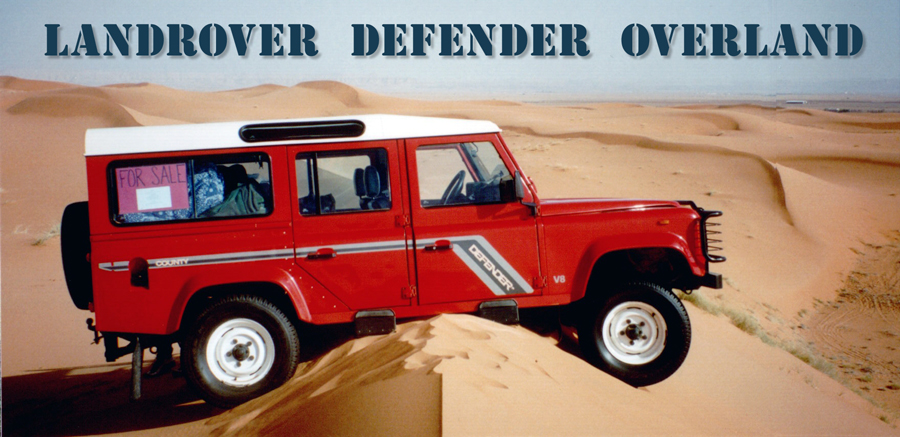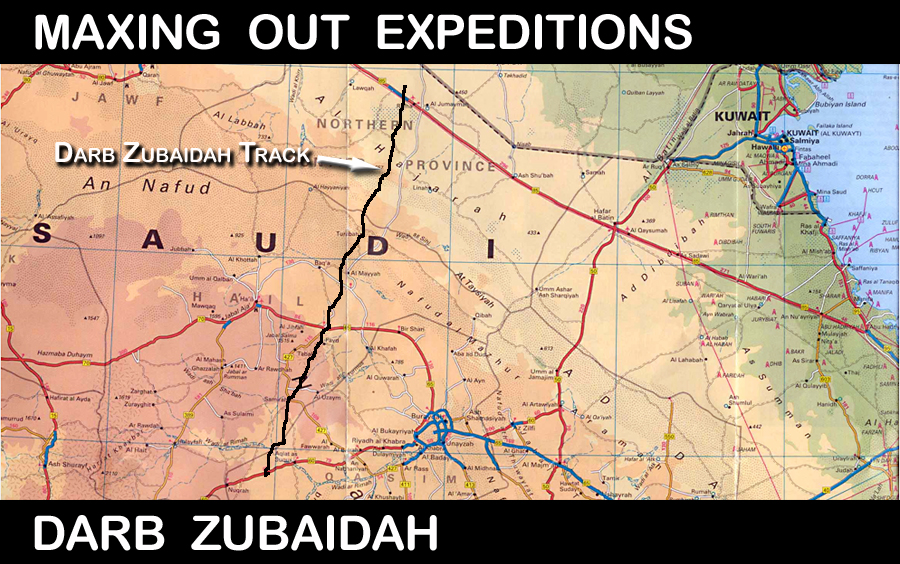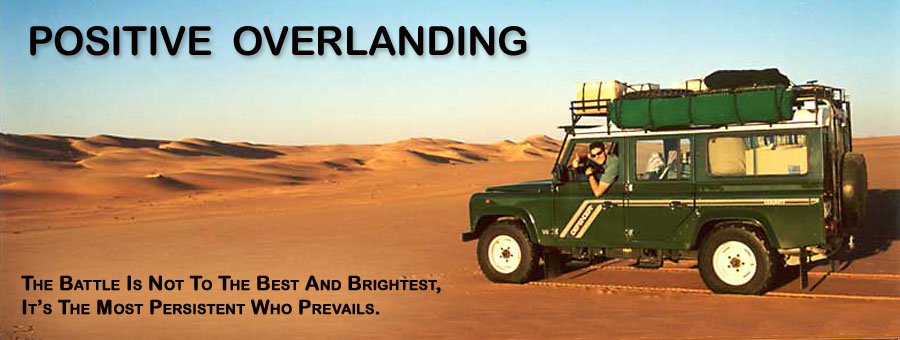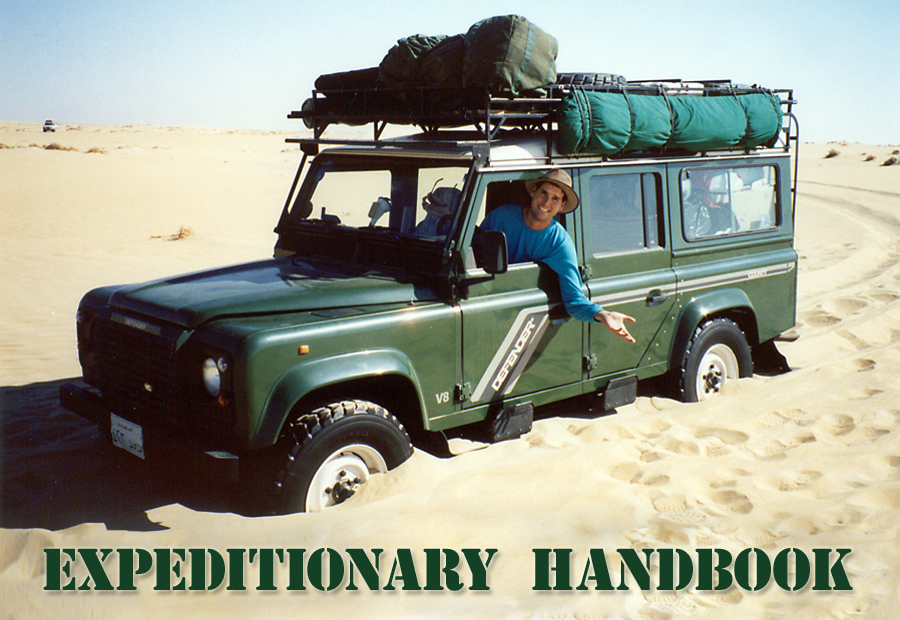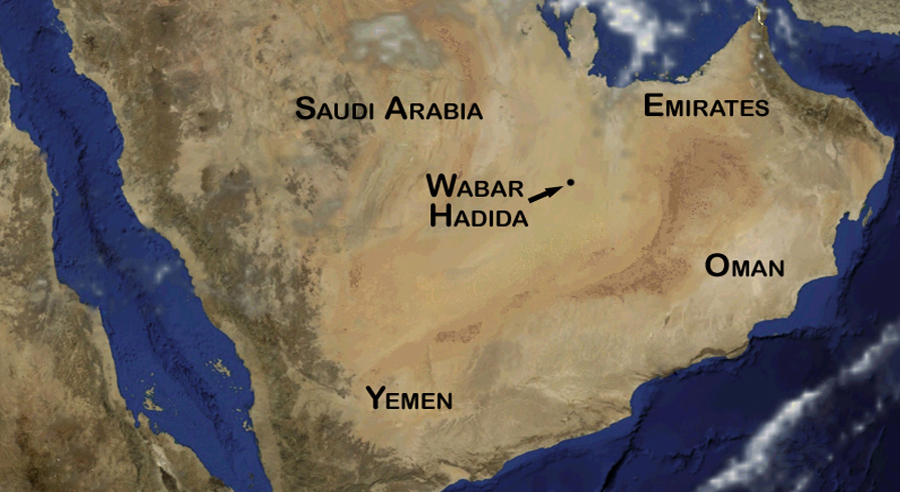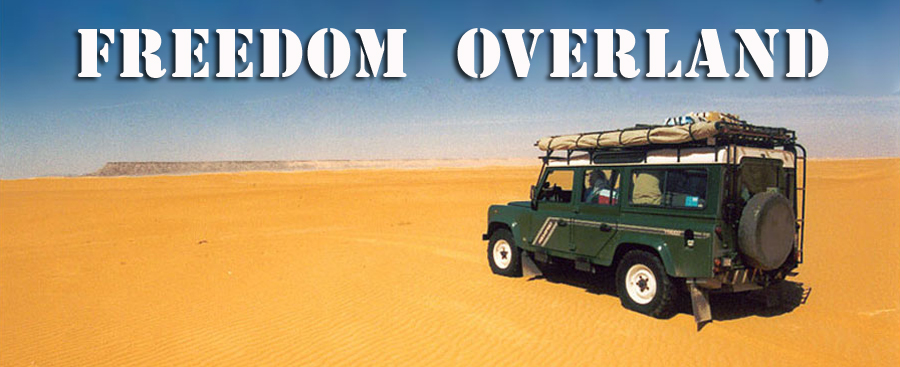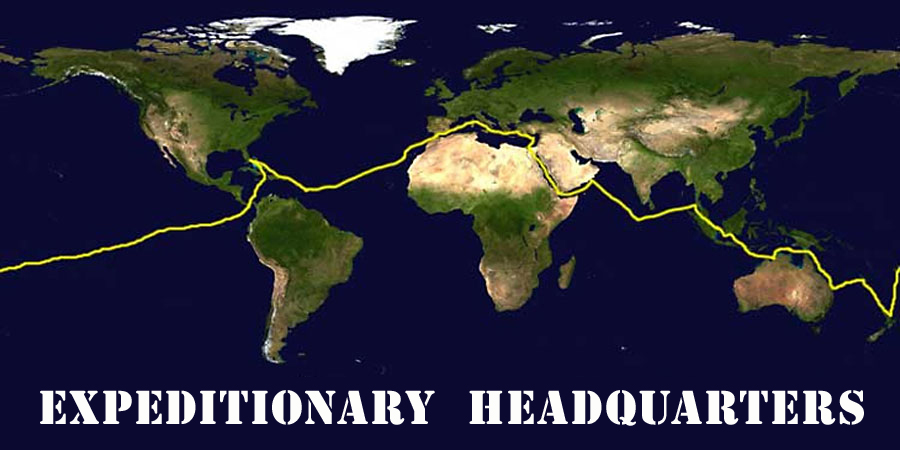 |
Join
Team Maxing Out
for their sailing and off-road adventures. They may be wandering, but
they are not lost. So where did they go? Some people would say
nowhere, but I would say, everywhere their heart desired. They went
everywhere they had the courage to point the bow of their sturdy
catamaran Exit Only, and everywhere they turned the wheels of their Land
Rover Defenders. They sailed more than 33,000 miles around the world on
their Privilege 39 catamaran including a trip through Pirate Alley and
up the Red Sea. Their Land Rover Defenders took them to Arabia, Oman,
United Arab Emirates, Mexico, Guatemala, Honduras, Nicaragua, El
Salvador, Costa Rica, Panama, New Zealand, and Australia. Soon the
adventures will continue with a driving trip around the world and a
sailing voyage back to Australia. |
 |
Discover the meaning of
Positive
Overlanding. Sand
driving teaches you about your limitations. The first lesson you learn
is that appearances are deceiving. Traversing a sea of sand may look
like a piece of cake, but fifteen seconds later you are monumentally
stuck with sand up to your chassis.You can't tell ahead of time how hard
the slogging will become until you get into gear and start moving.
Appearances truly are deceiving.The second lesson you learn is that the
only way to find out if limitations are real is to test them.If you want
to live your sand dreams, you have to test the sand all the time. You
must allow yourself the luxury of testing your limitations many times
each day. When you do that, you discover that you can do many things
you previously considered impossible. |
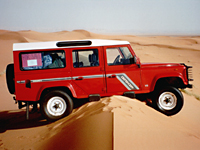 |
Landrover Defender Overland - When things don't work out as
planned, what should you do? Put a for sale sign of your Defender and
hope that a Bedouin with lots of cash shows up to put you out of your
misery? Sit around and feel sorry for yourself because you are
high-sided on the sand dunes of life? I don't think so. If you don't
have a snatch strap, and you are alone in the dunes, then it's time to
get out the shovel and start digging. Once the sand no longer touches
the chassis, you will be on your way. When plans don't work out, you
keep on digging, keep on fixing, keep on navigating, and keep on
driving.
|
 |
Expeditionary Sandbook -
My first trip into the Empty Quarter of Saudi Arabia
taught me the most important lesson of desert exploration that I ever
learned: DON'T DO STUPID THINGS! The
desert is unforgiving and doesn't treat fools lightly. Here is how I
learned that lesson.
|
 |
Freedom Overland
- For
me, the dream is all about adventure, freedom, and being really alive.
Although I like seeing the sights wherever we go, I think it's the sense
of adventure coupled with the freedom to do what I want to do with my
life, seasoned with a pinch of adrenalin that makes it all worthwhile.
It doesn't matter whether I drive down a hundred foot sand dune, sail
through pirate alley, or voyage across an ocean, I still get the feeling
that I am really alive and am accomplishing something that's important
to me. I'm living my dreams, and although it's a lot of work, costs lots
of money, and spends the currency of my youth, that doesn't matter,
because I'm doing what I want to do with my life as I live without
regrets. |
 |
Defender Offroad
- Daydreams are
easy. Just sit back and let them happen. Daydreams are effortless
adventure. It's easy to be a legend in your own mind. Real dreams are
hard. You can't sit around making bun prints in the sands of time if
you want to make your dreams come true. Real dreams aren't a trip to
fantasy land. They are rock solid adventures purchased with blood,
sweat, and tears, and the most precious commodity of all, time. I have
always been something of a dreamer. I have gone walkabout in my mind
for thousands of hours, and that's ok, because I have spent even more
time going walkabout on planet earth.
|
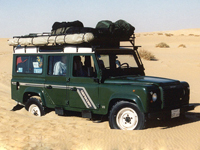 |
Maxingout
Overland - Each expedition into the Arabian desert is special
for different reasons. Some trips are simply to get away from it all to
experience the solitude and stark beauty of the Arabian shield. Other
trips have a specific destination in mind, and the destination defines
the adventure. The U.S. Geological Survey worked with the Saudi
government to create a set of maps of the geology of the Kingdom of
Saudi Arabia. My favorite survey map is the Southern Nejd Quadrangle.
A smorgasbord of sand dunes, wadis, granite fields, metamorphic mountain
ranges, and archeological mysteries abound in this quadrangle. When I
think of this area, the word "awesome" comes to mind. Take a trip with
Team Maxing Out to the Tombs of Bir Zeen. |
 |
Maxingout Offroad
- Travel with Team Maxing Out to the Hadida Meteor crater in the middle
of the Empty Quarter of Saudi Arabia. On the trip back from Hadida, I
had my opportunity to lead the expedition into a sea of soft sand. It
was high noon, and I had no clue that in a few seconds I would be up to
my chassis in golden sand. If I had a thousand dollars for every time I
have been stuck, I would be a millionaire. I'm grateful for all the
times I've been stuck over the years. That's what happens when I live
my dreams. I've been up to my axles in sand hundreds of times. That's
terrific because it means I am living my sand dreams. I've been stuck
too many times to count, and I hope my good fortune continues. |
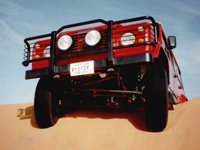 |
Maxingout
Expeditions - Travel with Team Maxing Out on the Darb Zubaidah
from Iraq to Mecca. More than a thousand years ago, Queen Zubaidah from
Iraq built an eighteen meter wide pilgrim road from Baghdad to Mecca.
The road was called the Darb Zubaidah, and millions of pilgrims walked
this road on their journey to perform Haj. We calculated the distance
and felt we could complete the trip in a week in our Land Rover Defender
110 expeditionary vehicles. We carried enough fuel and water for the
entire trip. Our Defender carried 430 liters of fuel in long range fuel
tanks and thirteen jerry cans. We had two hundred liters of water and
enough food to last for weeks. |
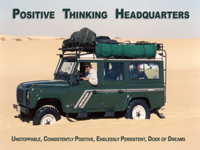 |
Positive Thinking Headquarters - The home of positive thinking
on the world wise web. I am grateful for all the times I have been
stuck over the years. That's what happens when I live my dreams. I've
been up to my axles in sand too many times to count, and that's terrific
because it means I am living my sand dreams. Positive Thinking
Headquarters is where you come to get unstuck. There is nothing wrong
with getting stuck as long as you don't stay there. It's time to
recover. It's time to become an Unstoppable, Consistently Positive,
Endlessly Persistent, Doer of Dreams. |
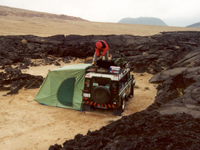 |
Overland
Defender 110 - Join Team Maxing Out as they make an expedition
to the white volcanoes of the Arabian shield. We decided that we wanted
to visit the white volcanoes of the Arabian shield just north of Medina.
The volcanoes are in a no man's land with lava fields stretching for
hundreds of miles. We would be foolish to make a solo trip to this area
in the heat of summer. But if it's the cold month of December, if we
have two spare tires and enough water to survive for a couple of weeks,
and if we are willing to burn one of our spare tires to make a smoke
signal in an emergency, then a solo trip is not crazy. |
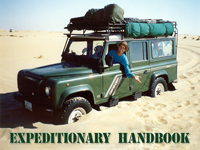 |
Expeditionary Handbook - Let Team Maxing Out show you the art
and science of expeditionary navigation in the Arabian Desert. Not all
expeditionary navigational problems are created equal, and your approach
to navigation varies with terrain, capability of the vehicle, and degree
of access to the land. Limited access makes navigation more
challenging, and unlimited access gives you hundreds of options when you
plan your expedition. Situational awareness forms the foundation of
successful expeditionary travel. Situational awareness means that you
know yourself, your vehicles, and the desert in which you travel. You
must know your vehicle well and understand its capabilities and
limitations. |
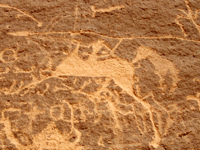 |
Rock Wall Journal - Team Maxing Out conquers a sand ramp in the
Empty Quarter of Saudi Arabia and then studies the petroglyphs of the
Rock Wall Journal. The ancient people who created the Rock Wall Journal
were not simple-minded cavemen waiting to evolve into real human
beings. These highly intelligent people had an appreciation for the
natural world in which they were immersed. They displayed their focus
on the natural world with stylized drawings that are still pleasing to
modern eyes. Although they had a limited palate and only a few tools
with which to work, they created unforgettable panels of rock art. |
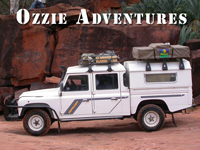 |
Arno's Wall - Everything Including the Kitchen Sink - Winton, Queensland
Ozzie Outback Murals - Life Before Cell Phones, Texting, and Twitter |
 |
Follow
Expeditionary Headquarters on Facebook |
|

We always traveled in a Defender 110 when journeying in the Empty Quarter.
During my sixteen years in Arabia, I owned three different Defenders, and
all of them did deep desert exploration.
Green Defender cruises the desert sands on Michelin XS sand tires at about
18 psi inflation. Examination of the pictures show the ballooning of
the tires giving excellent floatation in a loaded vehicle heading out for
a week in the sand dunes.When I first started
driving in sand, I tried driving at 25 psi, and I frequently bogged down
and had to recover the vehicle with sand ladders, winch, or tow strap.
Once I dropped the tire pressure down to 16-18 psi, I rarely got stuck.
At those tire pressures I have never broken the bead and slipped a tire on
the rim. I don't use any bead lockers.
We carry Arb air compressors to reinflate the tires
up to 35 psi when returning to the asphalt.
Green Defender has an awning on the right side of the vehicle, and a tent
mounted on the left side. The full length roof rack carries fuel,
food, firewood, sand ladders, and assorted camping gear.
This is my third Defender 110 with a 3.9 liter V8 gas engine.
This sand machine will take you anywhere you want to go in the Empty
Quarter as long as you have enough fuel. The V8 engine is amazing.
As long as you are in gear and have the engine under load, you can push
the accelerator all the way to the floor in first or second gear without
worrying about blowing the engine. It's not very fuel efficient, but
you can nearly always blast through soft patches of sand if you are in the
correct gear, and you have the accelerator all the way to the floor.
I have never heard of anyone blowing their engines while working at
maximum RPMs in the dunes.
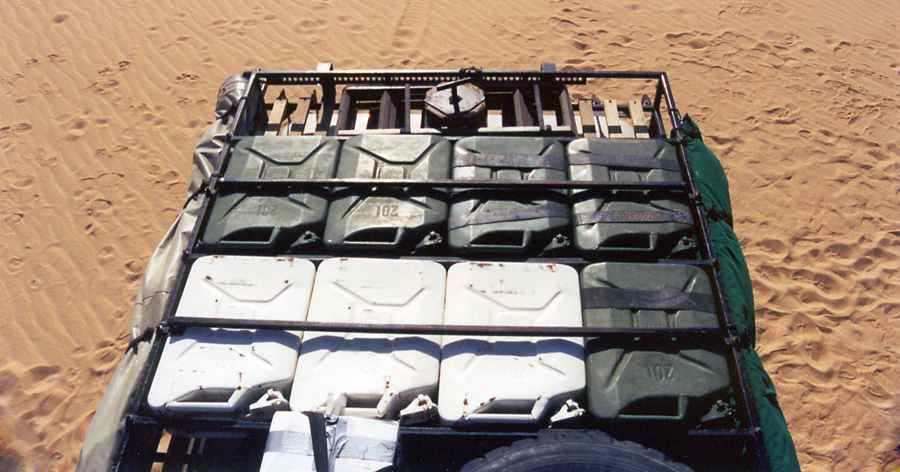
This is the roof of Green Defender. The Brownchurch style roof rack
carries eight jerry cans of fuel with jumper bars holding the jerry cans
in place. The back of the roof rack has a mount for sand ladders and
a high lift jack. The roof rack also carries boxes of water, boxes
of firewood and a second spare tire.
On the left side of the roof rack is an awning with poles, and on the
right side is a tent mounted to the vehicle.
On deep desert expeditions, we carry 13 jerry cans of fuel. Eight of
the jerry cans lay flat on the roof rack, and five reside in a purpose
made box in the back of the vehicle. In addition, we have an
auxiliary long range tank in the right rear wing that empties directly
into the main 80 liter tank. When fully fueled, we carry 430 liters
of fuel for deep desert exploration.
We calculate fuel requirements in the following manner. Using a map
measuring device, we trace our route on the map so that we accurately know
the number of kilometers involved. From experience, we know that our
Defenders get about 3.5 kilometers per liter on average in the sand.
We divide the measured distance for the expedition by 3.5 to figure the
amount of fuel needed, and then we add another 30 percent to compensate
for all the zig zagging in the dunes. Using this technique, we
usually come out of the desert with one jerry can still containing fuel at
the end of the trip. We have never run out of fuel on a deep desert
expedition.
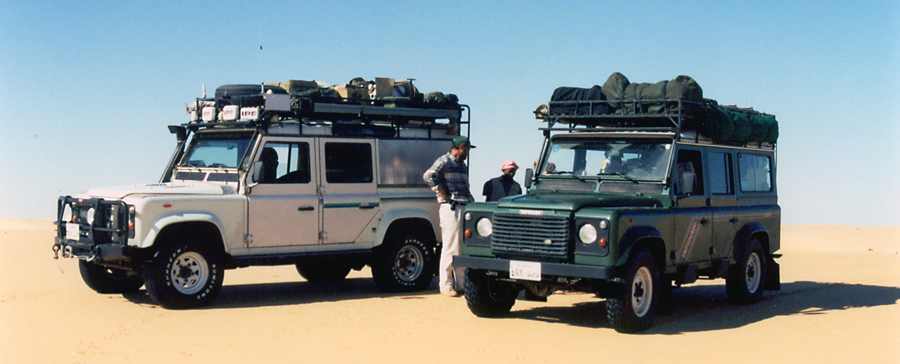
This trip has three vehicles. Two Defender 110s, and one Toyota Land
Cruiser. The Land Cruiser is running a 4.5 liter engine, and the two
Defenders have 3.9 liter V8s. All the vehicles have plenty of power
to deal with heavy loads and soft sand. The White Defender and Land
Cruiser have one advantage over the Green Defender. Both have
Shaheen sand tires designed for conditions just like this. Shaheen
sand tires have excellent flotation, and sometimes they float over the
dunes while my Michelin XS tires sink into soft sand.
When I first started driving in sand, I thought that wider tires might be
better in the dunes. It turned out that wider street tires did not
work better. They tended to act more like a sand plow and provided
less flotation. In really soft sand, they pushed sand in front of
the tire piling it up especially at slower speeds.
Shaheen sand tires have zero tread. They are like aircraft tires,
and they tend to hydroplane on wet streets. You must be very careful
driving on Shaheen tires on asphalt after a rain shower. You may
slide around like you are driving on ice.
People who spend lots of time in the sand frequently have two sets of
tires for their Defenders. One set is for driving on the streets
around town. The second set goes on just before you go on a trip in
the dunes.
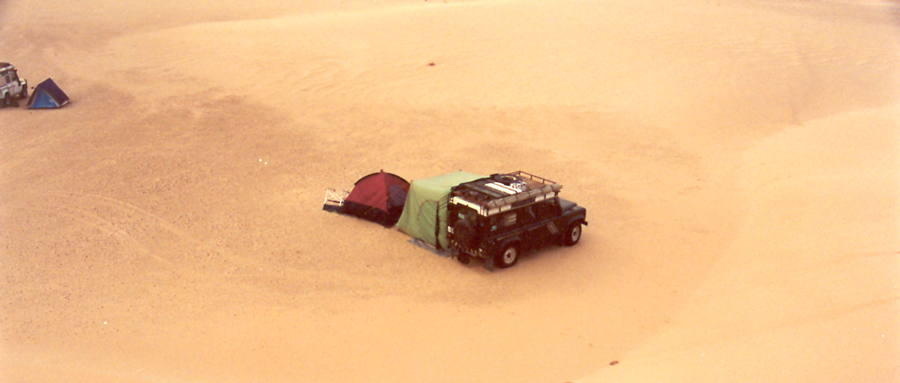
Our first camp on this expedition is in the small dunes of the northern
Empty Quarter. In this area, the dunes are like small rolling hills
of sand. You drive up one side of the dune and down the other side
without encountering a slip face. The dunes are tall enough that you
cannot see what's on the other side, but you can drive on them at a good
speed because you know there isn't a slip face on the other side.
The terrain is flat sandy plain with rolling hills of sand. When
it's time to camp at night, you pick a flat location that has firm ground
so that your Defender doesn't bog down at your chosen campsite.
Camping in the dunes is generally safe as long as you observe a few
important points.
Don't camp too close to the last sand dune that you
crossed before you set up camp. The reason is straightforward.
When Bedouins drive in the desert, they often follow the tracks of
vehicles that are ahead of them. This makes it much easier to read
the sand, If the tracks are solid, and if they don't sink into the
sand, then route finding in the dunes is much easier. You find a set
of tracks heading toward your destination, and you follow them. If
the tracks show that the leading vehicle bogged down, the following
vehicles diverge off the track so they also don't get stuck. If the
track looks good, they continue driving with much greater freedom and
speed.
Bedouins often drive in the desert at night when it's cooler. If
they like your track and follow it, you may have a rude awakening in the
middle of the night when they pop over the dune and into your camp.
Most likely it will scare both them and you. No harm is done as long as
you are not parked immediately on the far side of the dune.
On this particular campsite, that is exactly what happened. My
daughter wanted to camp at the base of the dune in the direction from
which we just came. She wanted to tuck her sleeping bag in the
danger zone. I told her that it was too dangerous, and she relented.
In the middle of the night, a truck came over the dunes and would have run
over her if she has been in that location.
We parked the Defender so that it protected everyone sleeping in our two
tents. That way if someone came barreling though at night, they might hit
our Defender, but they would not run over us as we slept. I probably
should have had put my Defender farther away from the dune to reduce the
risk to the Defender.
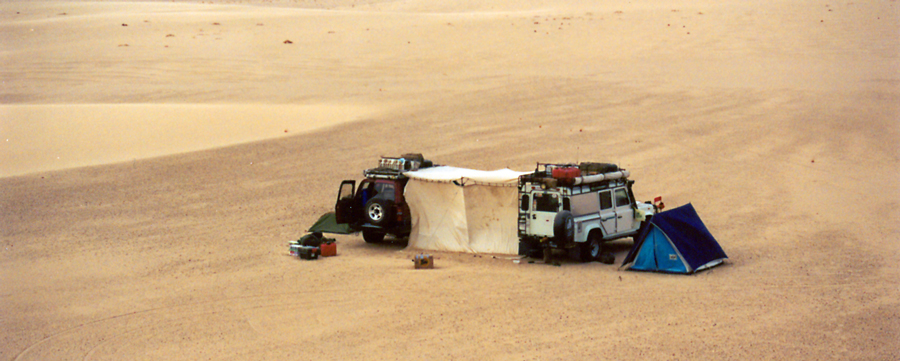
The other two vehicles camped further out on the sandy plain, and there
was no danger of being run down in the night by anyone unless they were
intoxicated or blind. Examination of the white shelter between the
two vehicles shows that the wind is blowing hard in this section of the
northern Empty Quarter.
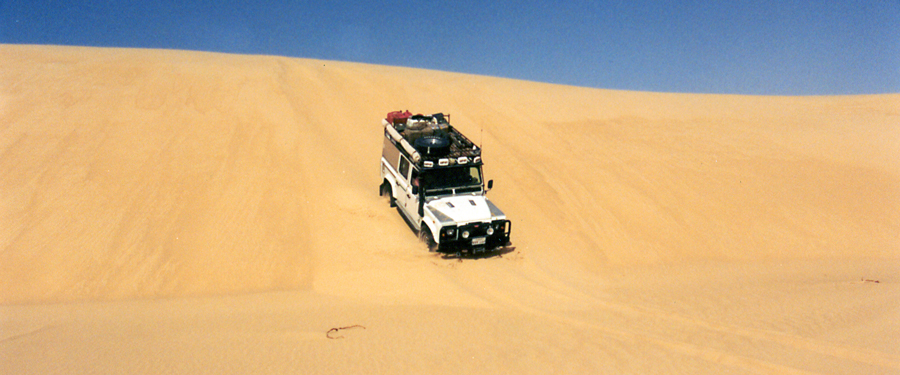
After traveling 200 kilometers south, the sandy plains and rolling dunes
disappear. Barchan dunes surround us on all sides, and as we journey
south, we slide down hundreds of slip faces as we traverse row after row
of dunes.
Because the prevailing winds are out of the north,
the barchan dune lines are oriented east to west. A single row of
dunes can extend for hundreds of kilometers in the southern Empty Quarter.
Once the Barchan dunes begin in earnest, you cannot drive around them.
It's over the top and down the slip face as you head to the center of the
Empty Quarter. Heading south is the easy direction of travel.
When you turn around and go back the other way, you spend lots of fuel and
time searching for sand ramps that will allow you to ascend the dunes to
get around all the slip faces that dominate the countryside.
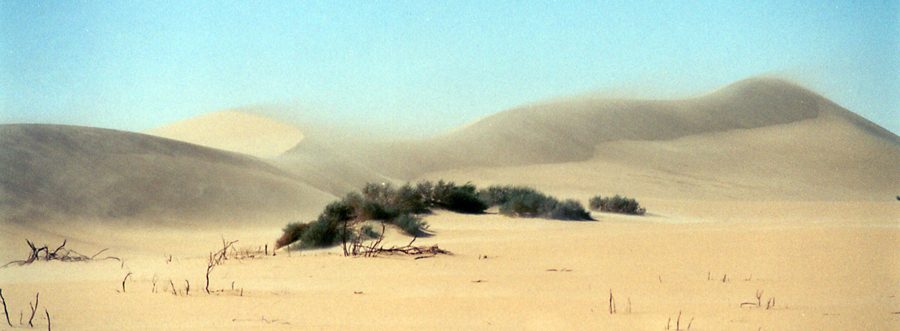
When wind blows strong out of the north, the sand
flies in sheets off the tops of the dunes. If you get downwind of
these dunes, you better put on your sand goggles, or you will get a ton of
sand in your eyes.
The blowing sand deposited on the downwind side of the dunes takes a long
time to compact into firm sand. It frequently is powder soft, and if
you attempt to drive there, you may sink up to your chassis. You
wouldn't want to drive or camp there because blowing sand gets into
everything and camping is miserable.
Sometimes you get stuck at the bottom of a slip face because you are going
too slow as you descend, and when you hit the bottom, a soft sand trap
awaits. This tends to be a greater problem in larger dunes than
smaller ones. As you come slowly down the side of a slip face, it's
a good idea to accelerate near to the bottom just in case you are entering
a sea of soft sand. A heavy foot on the accelerator may allow you to
power through the sand trap and move forward far enough to get on firm
ground.
Bushes and obstacles on the far side of a slip face can be a nasty
surprise. You pop over the top of the dune, and foliage at the
bottom blocks your way at the base of the dune. That is a great
formula for getting stuck at the bottom, and it will be a major exercise
in vehicle recovery because maneuvering options are limited.
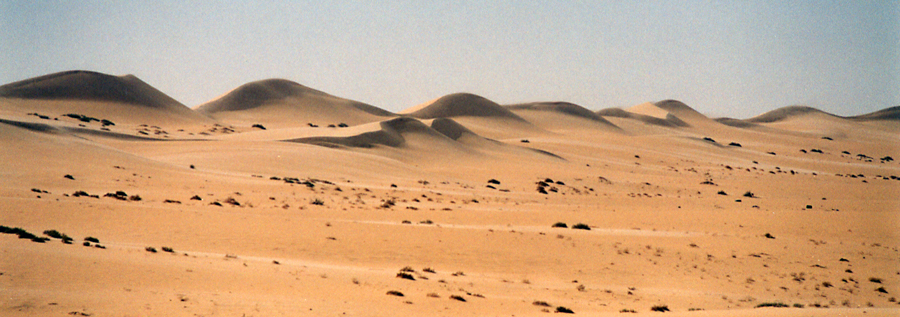
Calculating your fuel requirements must take into consideration that
traveling in the dunes is a two way street. You probably are going
to return home in approximately the same direction from which you came.
Going against the dunes requires more fuel than going with the dunes.
When you go south with the dunes all you need to do is ride down the slip
faces and enjoy the trip. There will be soft patches here and there
that will stop you in your tracks for a short time, but at least you are
not traveling against slip faces. Going against the dunes requires
more fuel and route finding is a bigger challenge. You can't travel
in a straight line. You spend time traveling in the valleys between
the dunes looking for sand ramps that will get you over the slip faces.
Sometimes, you may need to drive ten kilometers before you can find a sand
ramp that will get you over a particularly large dune with a giant slip
face.
The left side of this picture has several sand ramps that are good
candidates for getting you up and over the dune line.
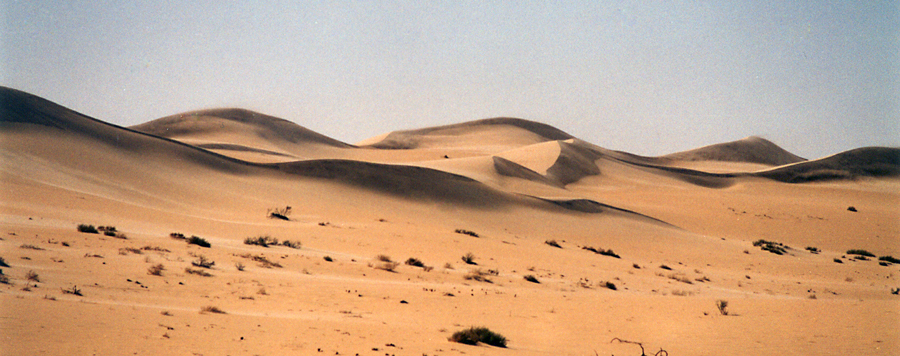
Going against the dunes gets more complicated when dunes are stacked on
one other in two or three levels. In this situation, you find a sand
ramp that gets you over the first row of dunes, and then you drive on the
higher level looking for a second sand ramp that will put you over the
second row.
Sometimes there is no way over the second or third level, and you have to
descend back down from whence you came. Then you travel parallel to the
dunes once again until you find another sand ramp and attempt to go up and
over, and hopefully around the slip faces that block your way home.
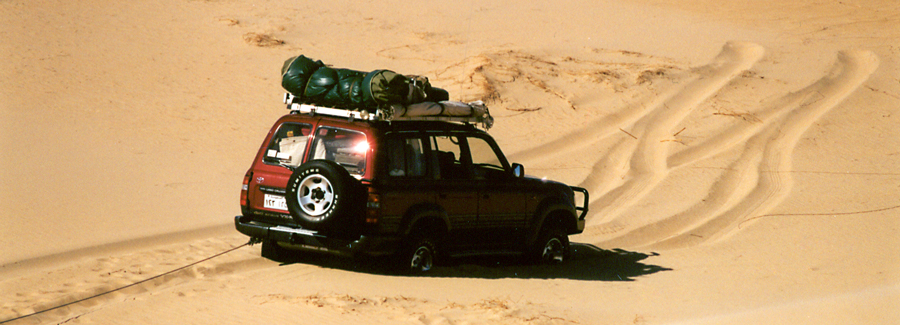
Reading the sand is difficult. The lead vehicle that does route
finding is the one that gets stuck most frequently. It's simply a
fact of life when you drive in sand. There is simply no way of
knowing that sand will be soft by just looking at it.
If it is important that we don't get stuck for some strategic reason, then
the best way to find out if the sand is soft is to get out of the truck
and walk in front of the vehicle. You walk to the right, left, and
straight ahead.
If you are lucky, firm sand may be two feet in front of your truck.
Sometimes, if you turn left you will be on terra firma in ten feet.
But when you walk in front of your truck, and there is nothing but soft
sand for hundreds of feet, the smart thing to do is to come out backwards.
It's faster and less exhausting on people doing vehicle recovery.
If the ambient temperature is 100 degrees, it's not safe to use sand
ladders and push by hand when vehicle recovery requires an hour of hard
work. Someone will get heatstroke at worst, and everyone will end up
dehydrated at best.
The Land Cruiser determined that it was impossible to move forward to firm
ground, and the quickest and easiest way to recover this vehicle is to use
a winch. In a few minutes of winching, the expedition is once again
on the way to the meteor crater.

Later in the day, shadows grow longer and sand takes on a darker
appearance. Depending where you are in the Empty Quarter, sand
varies from a reddish color to a pale tan, and everything in between.
Getting between the slip faces in this picture would be easy as there is a
well-developed sand ramp between the two slip faces. It doesn't get
any better than that when you want to travel against the dunes.
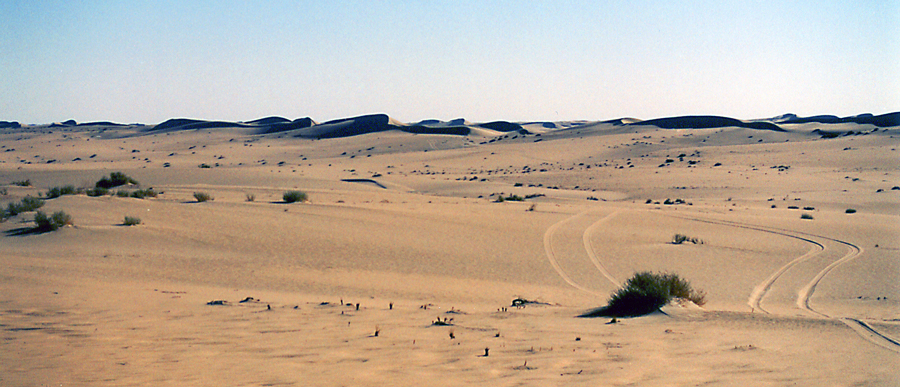
As you travel south, rows of dunes often spread out. You may have
two or three closely spaced rows, and then you have rolling hills of
beautiful sand for a kilometer or more before you come to the next row of
well-developed dunes. In the valleys between the dunes, the sand
tends to be firm, and it's pure joy to glide over the sand. The tire
tracks to the right show that the sand is relatively firm. When I
drive over sand like this it reminds me of sailing over ocean swells in
the Pacific Ocean, and the best thing is that the sand swells don't move.

It's late afternoon, and shadows grow long as the golden hour approaches.
Sand takes on a golden hue, and life is good. Tire tracks in the
foreground reveal the presence of exceptionally firm sand.

Why does this campsite have a circle of tire tracks all around?
We commonly make such a circle when choosing our camp just to be certain
that we aren't setting up a camp in soft sand. If we bog down when
we drive in a circle, we move to a different location.
Ending the day by bogging a vehicle in a campsite is a poor way to finish
an expedition in the dunes. Equally, waiting until morning to
extract a bogged vehicle is not the best way to start a day.
Hence, we drive around our campsite to test the sand
before we choose our final resting place for the night.

Reading the sand is most difficult at high noon. Shadows from the
morning are gone, and intense sunlight directly overhead reduces contrast
to such a low level that it's easy to make serious mistakes. Without
the contrast, you may drive off a small slip face without realizing it's
there until your car suddenly drops three feet - a very rude awakening.
The opposite can occur. You may not see a two foot sand ridge
in front of you until your vehicle hits it and pops violently up over the
elevated sand ridge. Mistakes like that place great strains on your
suspension and frazzle your nerves. One of my friends drove his
Defender off a small slip face that he did not see, and flexing of the
vehicle's chassis resulted in a permanent wrinkle in the skin of his
Defender next to his left rear tail light. Hogging of the frame can
put creases in the sheet metal.
I have seen Defenders pop over a ridge of sand that they did not see, and
suddenly the vehicle starts making a horrible grinding noise.
When the Defender went over the sand bump too fast, it broke one of the
engine mounts. Now when they step on their accelerator, the engine
twists slightly in the engine bay, and the fan rubs on the fan shroud
making a horrible noise.
When I was learning to drive in sand, my instructor showed me how to bump
my Defender over a three to four foot slip face (from the wrong side of
the slip face). If you drive up to it at just the right speed, your
Defender will bounce up and over the slip face. It's a great
technique when it works, but it's also the recipe for breaking an engine
mount. If you are going to do stuff like that, you better carry
spare engine mounts when you are traveling in deep desert.
Although there isn't much contrast in these dunes, you have one important
factor in your favor. Wheel tracks ahead of you reveal a safe path
through the dunes. By looking at the tire tracks, you can see where
the sand is firm and where it is soft, so you know when you need to step
on the accelerator. When the going gets tough, and there is no
contrast in the sand, we always look for tire tracks to make our journey
easier.

In the foreground just beyond the ripples in the sand, a light colored
band goes from one edge of the picture to the other. This light
golden band is one of those tricky sand surfaces that can fool you as you
approach it in conditions of low contrast. The golden band may be a
three foot high wall of sand that you may pop over and in the process
break an engine mount. That same surface may have a gentle slope and
not be a problem. Sometimes you have to stop your truck a distance
off to discover what's happening so you don't make a serious mistake in
deep desert.
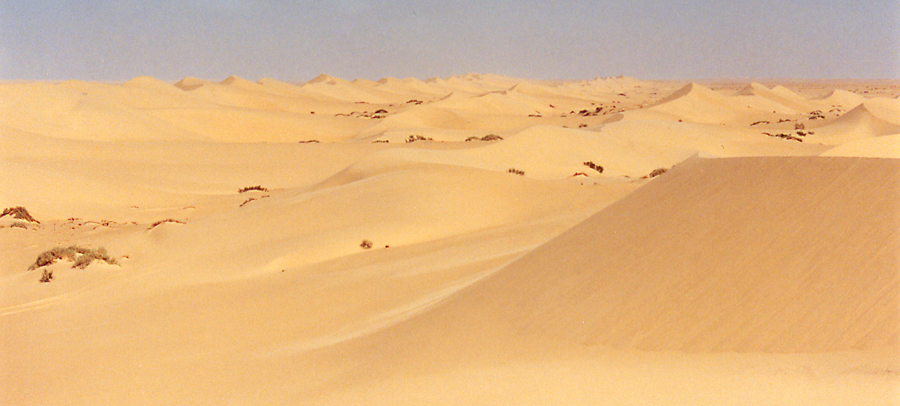
This line of closely spaced dunes is very tough to navigate at high noon.
You don't want to drive fast because low contrast makes it easy to to have
a problem. At the same time, the dunes are closely spaced with an
irregular pattern of sand hills. In this location, winds alternate
between two different directions. The dominant wind pattern is from
the north causing the longitudinal rows of dunes. But in between the
longitudinal dunes are secondary dunes created by winds from the east.
The jumble of east/west dunes mixed in with north/south dunes means tough
going, especially at high noon when there is little contrast.
I would avoid the dunes in the distance and make my best efforts to escape
this mess by traveling right to left in the foreground where there are
some barely perceptible tire tracks on the left side of the picture.
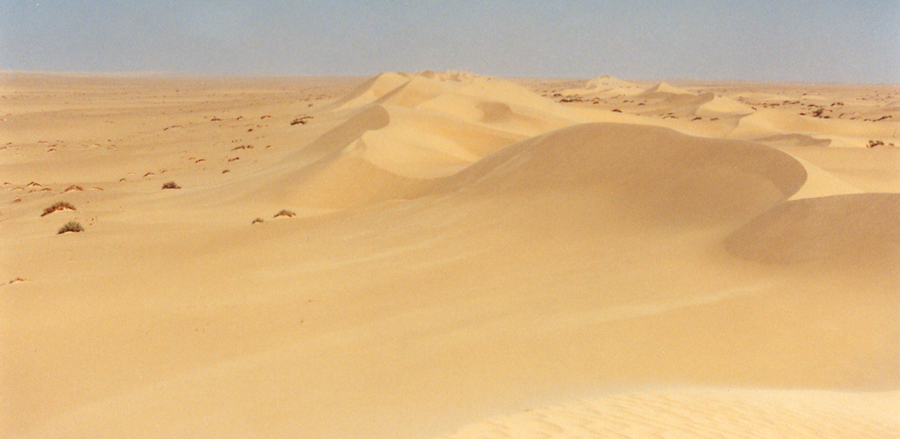
Low contrast means drive with care. Whether you are heading north or
south, it appears that these two lines of dunes terminate about a
kilometer in the distance. In this case the better part of valor is
to make an end run around the dunes rather than try to go over them in
conditions of low contrast.
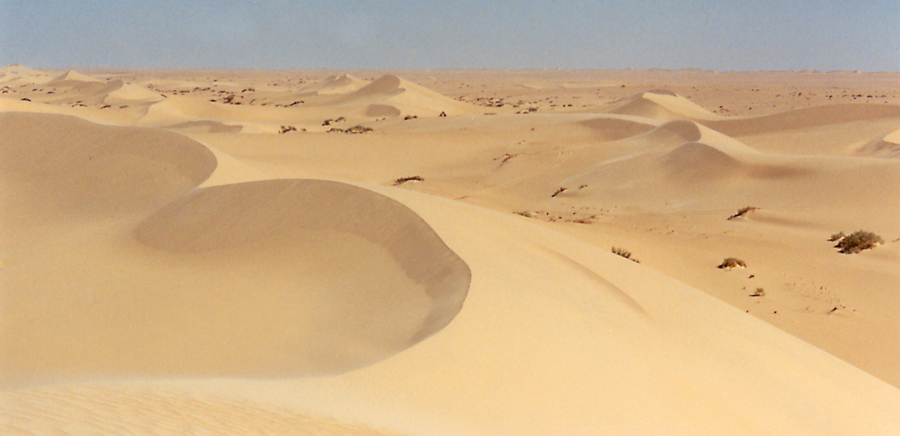
Contrast is relative low, but a passage through the dunes looks within the
realm of possibility. The dunes are closely spaced, and if the sand
is soft, you are in trouble. Trucks will bog down. If the sand
between the dunes is firm, you will breeze though wondering what everyone
was worried about.
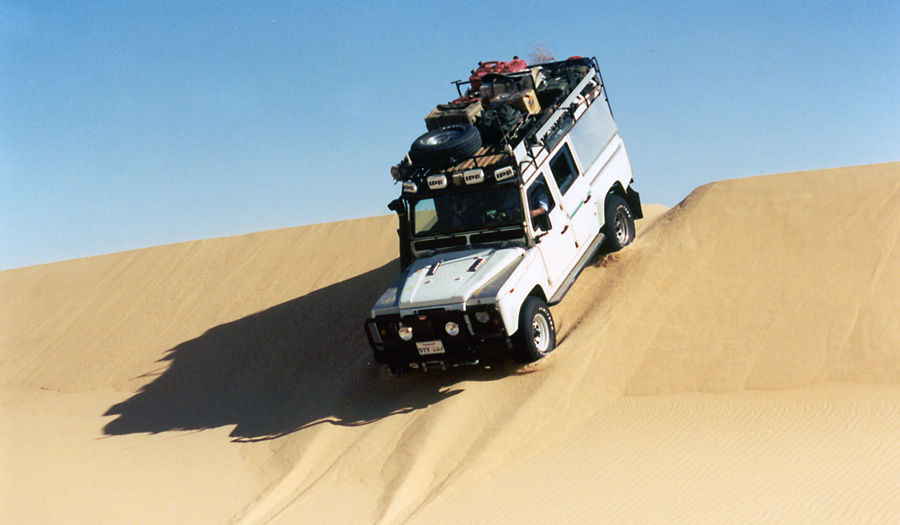
Driving down a slip face is true joy. The sand on this slip face is
relatively firm as the Defender isn't sinking down to the chassis as
frequently happens on large slip faces.

Red Land Cruiser is gutting it out driving through soft sand on Shaheen
sand tires. I have seen him drive out of a bogging situation like
this by lowering tire pressure down to 8 psi, and then putting the vehicle
in lowest gear and slowly creeping forward or back. You can quickly
tell whether you can creep out of a sand bogging by watching the vehicle
and tires. If the vehicle moves forward or back a tiny bit at a
time, the technique may work. If the tires simply spin and the
vehicle sinks down further, then it's useless to continue spinning the
tires. It will only make things worse.
If you have sand tires and you are willing to lower your pressure down to
8 psi, you can sometimes drive out of a serious bogging.
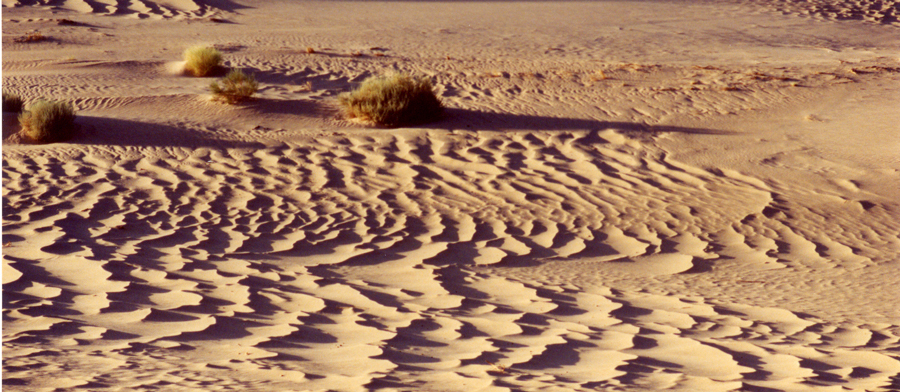
When I first drove in the Empty Quarter, I coined a new saying, "SASTRUGI
HAPPENS".
Sastrugi are the wavy elevated ridges of sand created by blowing sand.
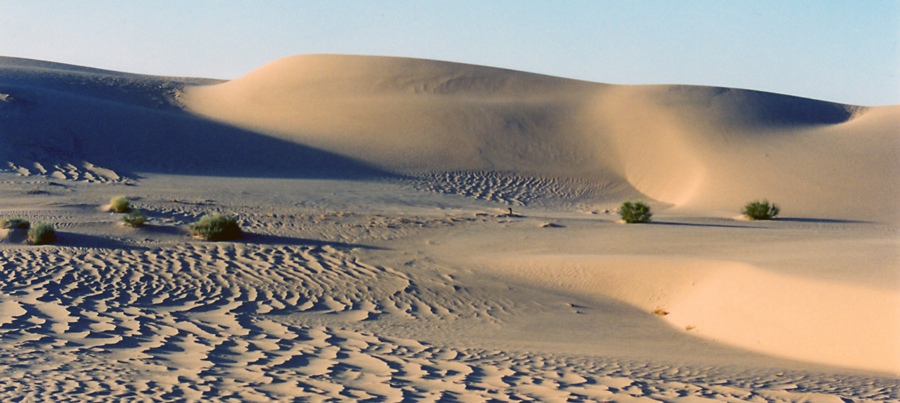
Sastrugi comes in two types. There is hard sastrugi and soft
sastrugi.
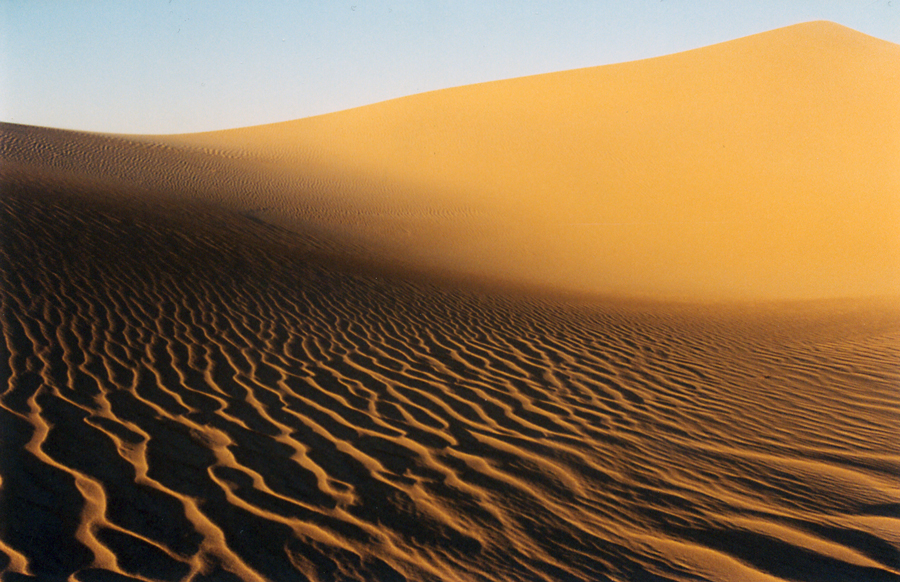
Sastrugi happens in the valleys between the dunes. Hard sastrugi is
very hard, and feels like driving over giant corrugations or speed bumps.
It will shake your vehicle until you wonder if something is going to
break. It will shake your teeth until they rattle.

Soft sastrugi is soft like quicksand. It looks
like you are going to be hammered by severe corrugations as you approach a
patch of sastrugi, but the instant you enter it, you immediately sink up
to your chassis in soft sand.
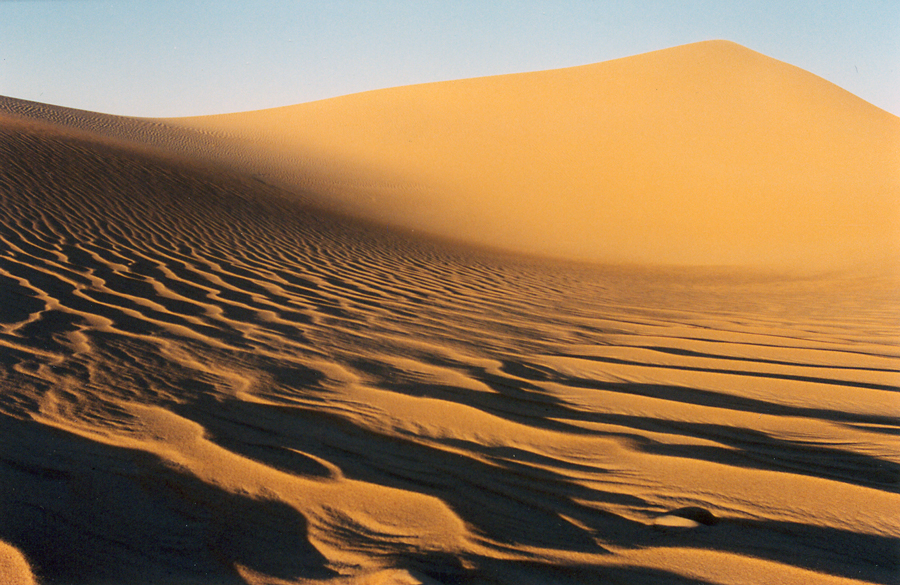
You can't tell ahead of time whether the sastrugi is going to be of the
hard or soft variety. You simply must drive though it to find out
what is going to happen.
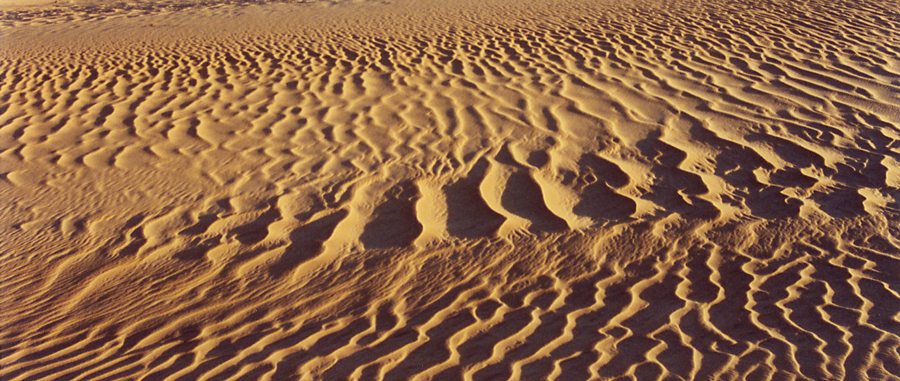
If you think the sastrugi is soft, you step on the gas and try to blast
through it. If it turns out that the sastrugi was actually hard and
you are going too fast, the sastrugi will shake your vehicle to bits, and
unsecured gear will be flying around in your truck by the time you reach
the other side.

If you think the sastrugi is hard, you let up on the accelerator and slow
down so it won't shake everything up. If it turns out that the
sastrugi is actually soft, you instantly bog down in the soft sand.
Some days you feel like you can't win.
When you encounter sastrugi, you have several options. You can drive
around it like a skier doing the giant slalom. You can stop your
truck before you get to the sastrugi and walk through it to see whether it
is hard or soft. You can hang back and let someone else drive though
it. You instantly discover whether it is hard or soft when you look
at his tire tracks. If it is soft, you put your foot down and blast
through. If it is hard sastrugi, you drive though at a slow and
gentle pace.

In late afternoon, the dunes look like King Midas reached down and turned
the dunes to pure gold. This is the stuff from which sand dreams are
made. Every time I set up my camp in the golden dunes, I feel like I
won the lottery of life, and this is my prize. I could come back to
these dunes a thousand times and never tire of them.

We like to arrive at camp by 4 p.m. so there's plenty of daylight to set
up camp and cook our supper before dark. In the late afternoon, we
have a chat about possible places to set up our tents. It's not hard
to find a place in a million square miles of sand. The only decision is
whether you want to camp high or camp low.
The people on this expedition generally prefer to camp high so they have a
tent with a view. Other's prefer to camp low where it's harder to be
discovered by passing vehicles.
During daylight hours, you are never aware of other vehicles in the
Empty Quarter. But at night the desert comes alive. You
sit around the campfire or lie on your cot listening to vehicles far off
in the distance. If you pop your head out of the tent, you see the
loom of headlights bobbing in the night sky as Bedouins drive at night in
the dunes.
In the daytime far off the beaten path, you feel like you are exploring an
isolated solitary world. At night you realize you are never alone.

I wonder where we should go next? Hmm. I
know. We'll just follow these tire tracks and discover the
Wabar meteor crater in the center of the Empty Quarter.
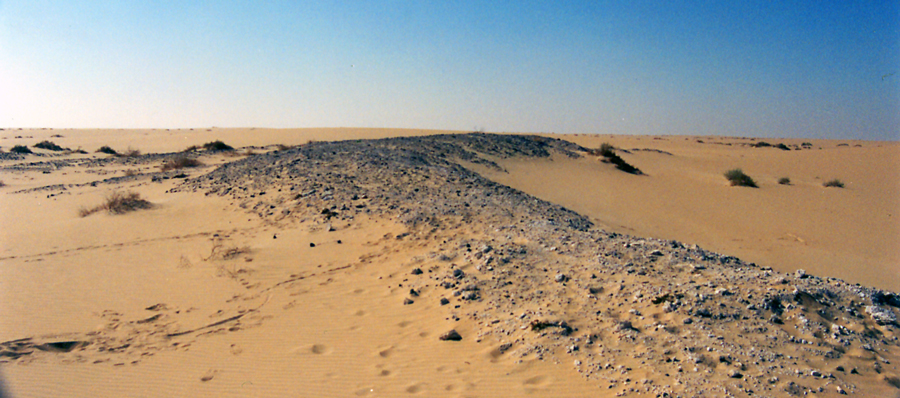
Welcome to the Wabar Meteor Crater, also known as Hadida.
The Wabar meteor broke up into multiple fragments before it struck the
dunes. It's unclear how many craters are present at Wabar, and we
will probably never know. That type of research takes lots of money
to answer questions that only a few people are asking. Some craters are
obvious, and others have filled in with sand in the past four hundred
years. Lots of sand gets moved around in the Empty Quarter in 400
years.
When the meteor struck the dunes, it ejected tons of superheated debris in
concentric rings around the impact site. It looks like the remnants
of a giant campfire in which the sand caught fire leaving charred remains.
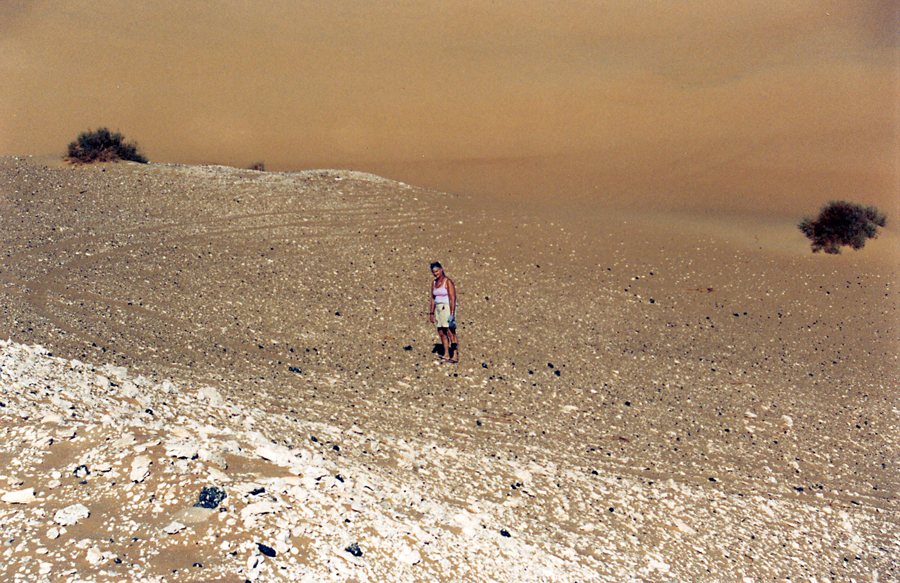
Donna stands on the sloping side of a meteor impact site. At the
present time the hole is no more than 50 feet deep compared to the present
height of surrounding dunes. One wall of the impact site is
relatively vertical, and the other side slopes gently downward and is
covered with melted and compressed sand.

The color of the debris varies significantly from location to location.
Some areas have mostly white debris, and in other areas the debris is
mostly black.

This debris ejected from the impact site gives a clue to the location of
the meteor strike. Since the force of the meteor hitting the earth was the
equivalent to that of a thirteen kiloton bomb, it surely must have created
a deep hole. One the other hand, scientists believe the meteor came
in at a very low angle, and that may limit the size and depth of the
original crater. According to excavations in 1932, the largest
crater was12 meters deep.

Debris consists of white impactite (a sandstone like rock formed from
compressed heated sand), and black glass formed from melted sand.
The impactite appears white through and through, and you can see the
striations where layers of sand were compacted together. The black
glass rock was molten, and it takes different forms. I contains bits
of impactite, and fragments of the iron and nickel meteor.

The laminated compressed structure of white impactite is clear. It
is lightweight and feels like piece of white cinder.

Melted superheated sand formed the black glass seen all over the site.
Some of the smaller pieces of black glass look like black tear drops.
Some have an obsidian-like appearance but without conchoidal fractures
seen in obsidian. Melted black sand incorporates white pieces of
impactite and rusty meteor fragments. This specimen of black glass
has two spots of rust from the iron found in the meteorite.
The Wabar meteor is composed of iron and nickel. The alternate name
for this site is Hadida which is the Arabic word for iron. Even
before geologists understood the nature of this site, Bedouins had figured
out that it was a source of iron in the middle of the desert sands.
Hence, they named it Hadida.
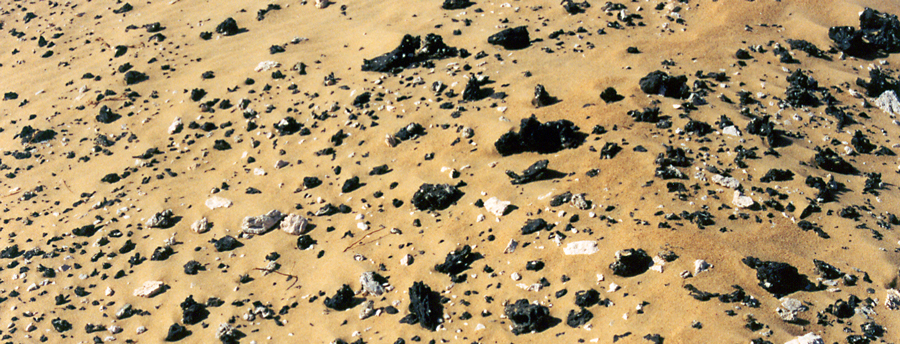
Extensive fields of impactite and black glass surround the Wabar crater.
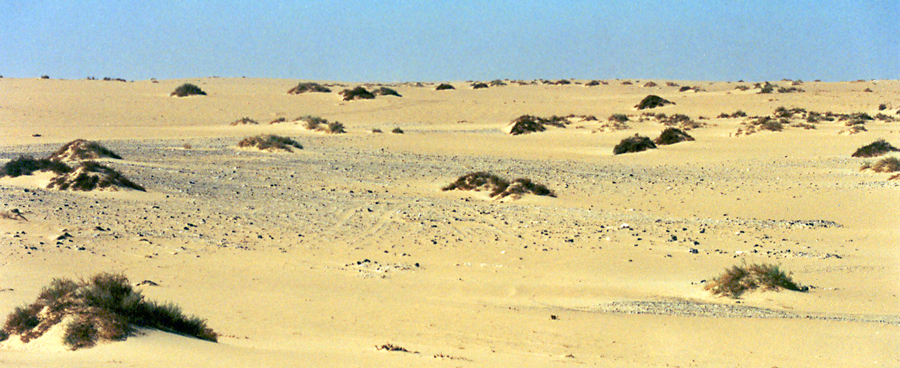
Sand dunes are gradually reclaiming the impact site. Wynn and
Shoemaker's article in 1998 Scientific American magazine states that the
largest crater was 12 meters deep in 1932, eight meters deep in 1961, and
nearly filled with sand by 1982. It won't be long in the geologic
time scale before Hadida disappears below the sands. If you want to
know more about the Wabar Crater and its geology, search Google for "The
Day the Sands Caught Fire" by Wynn and Shoemaker.
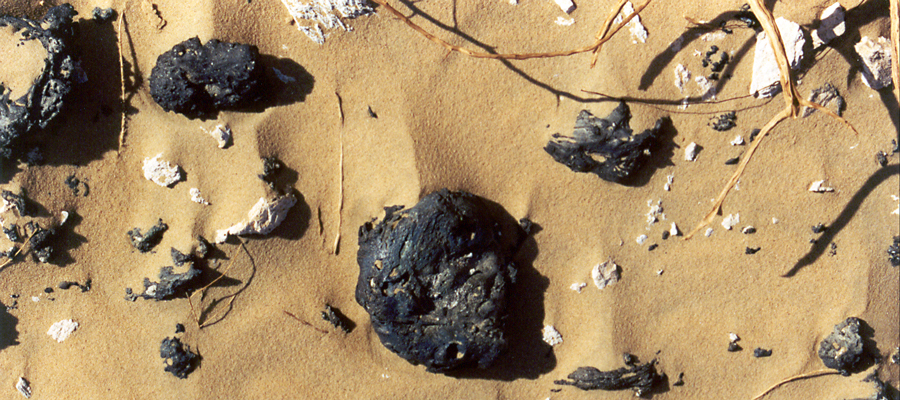
As the winds from the north deposit more sand in the Empty Quarter, the
Wabar Crater will eventually disappear beneath the dunes. The craters will
fill in and the impactite and black glass will be covered by advancing
dunes.
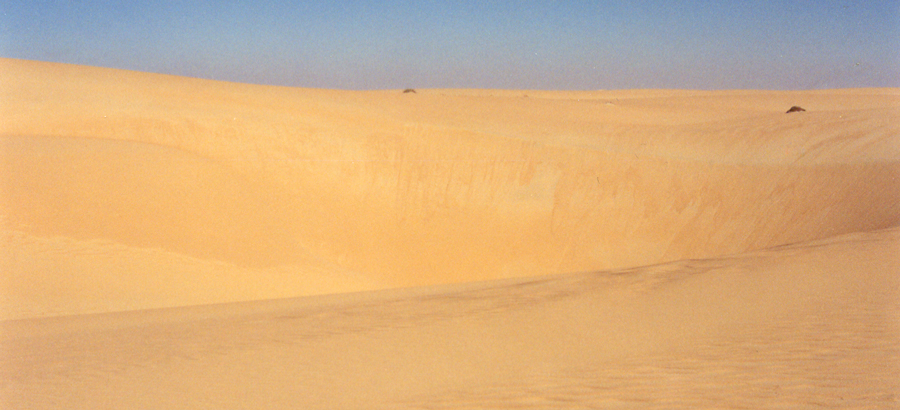
The big hole at Hadida is nice to look at, but don't ever drive your
Defender down into the hole. It will stay there forever because
there is no way to drive out.
Holes like this are a reminder to pay attention to what you are doing in
the dunes. Always look before you leap, because some mistakes are
forever. The further south you head in the Empty Quarter, the
bigger the dunes become. I have driven down slip faces that are more
than 200 feet high, and before you drive down, you better be 100 percent
sure that you are not descending into the pit of despair. It's hard
to imagine anything worse that leaving your Defender in the Empty Quarter
because you stupidly drove it into a hole.
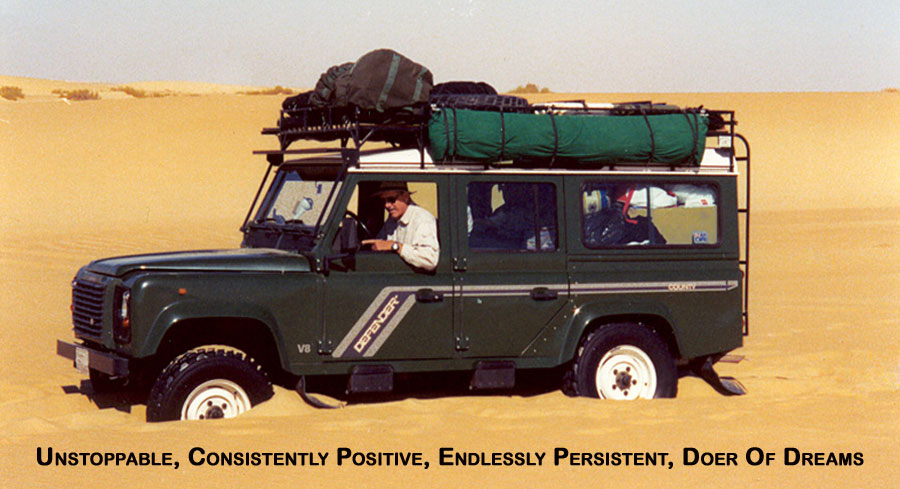
On the trip back from Hadida, I had my opportunity
to lead the expedition into a sea of soft sand. It was high noon,
and I had no clue that in a few seconds I would be up to my chassis in
golden sand.
If I had a thousand dollars for every time I have been stuck, I would be a
millionaire.
I'm grateful for all the times I've been stuck over the years.
That's what happens when I live my dreams.
I've been up to my axles in sand hundreds of times.
That's terrific because it means I am living my sand dreams.
I've been stuck too many times to count, and I hope my good fortune
continues.
Life is good.
 |



